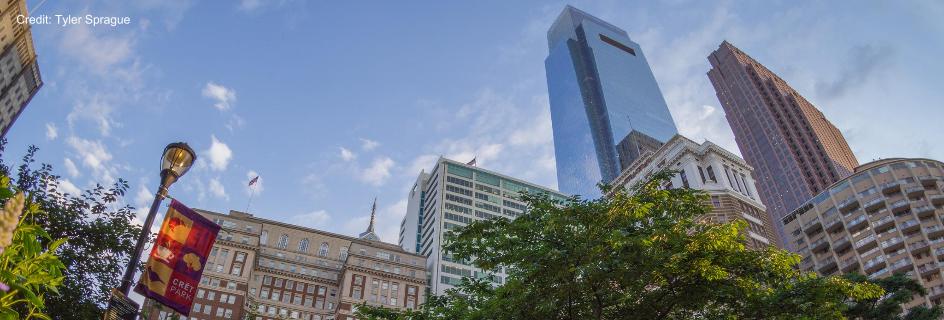- About GPA
- Global Events
- GLOBAL NEWS FROM PHL
- Global Directory
- World Heritage City
- Sustainable Development Goals (SDGs)
- Global Philadelphia Role on Sustainable Development Goals
- Completed Sustainable Development Goals
- SDG#1: No Poverty
- SDG #2: Zero Hunger
- SDG#3: Good Health & Well-Being
- SDG#4: Quality Education
- SDG#5: Gender Equality
- SDG#6: Clean Water & Sanitation
- SDG#7: Affordable and Clean Energy
- SDG #8: Decent Work and Economic Growth
- SDG #9: Industry, Innovation, and Infrastructure
- SDG#10: Reduced Inequalities
- SDG#11: Sustainable Cities and Communities
- SDG#16: Peace, Justice and Strong Institutions
- SDG#17: Partnerships for the Goals
- Press
Home ›
A Closer Look At The Print Center
Posted on August 9, 2019

“Whatever they may do, authors do not write books. Books are not written at all. They are manufactured by scribes and other artisans, by mechanics and other engineers, and by printing presses and other machines.” Roger E. Stoddard as quoted by Roger Chartier in The New Cultural History.
As a society, we have been taught to never judge a book by its cover. Historians have upheld this old adage for centuries by choosing to value a book based on the meaning its words convey, not its physical pages. They saw the text as semantically stable, dividing the seemingly inseparable concepts of a story and a book.
Perhaps some of the first to disagree with this notion were the creators of The Print Club. Founded by a group of collectors from Philadelphia in 1915, The Print Club was established years before the proponents of The New Cultural History published their thoughts on the subject. Viewing paper and printing itself as an art form, the organization was formed for the study and collection of works by local and international printmakers. In 1918, The Print Club moved into a building at 1614 Latimer Street, which they still occupy today. At the time, the organization used their new home to plan exhibitions, including dozens that traveled across the region and the world. These tours featured a variety of mediums, with an emphasis on highlighting marginalized media forms like reproductions and photographs.
In an effort to promote inclusivity, The Print Club chose to officially change its name to The Print Center in 1996. Today, The Print Center is most famous for hosting its ANNUAL International Competition, which highlights artists who critically use printmaking and/or photography and challenge the norms of traditional practices. They also host the Artists-in-Schools program and group and solo exhibitions. The most recent exhibitions, James Siena: Resonance Under Pressure and New Typographics: Typewriter Art as Print, ran from April 19 to July 27.
Resonance Under Pressure featured 10 prints James Siena designed between 2017 and 2018 while working in residency programs at a series of universities. Known for his paintings of brightly colored labyrinthine forms, the 10 works on display featured the artist’s exploration into biomorphic forms and revealed his interest in the production of text as art. The artist handmade his paper for the exhibition and included several proofs alongside the finished products, which emphasized the method of production and its materiality.
Siena’s exploration into the materiality of text was most evident in his letterpress print, which he made in collaboration with MICA’s Dolphin Press & Print. One of these works, Roma tibi subito motibus ibit amor, was inspired by Siena’s experience with a typewriter while in residence at American University in Rome. Adding to his letterpress portfolio, Another work, is it I? It is I! featured typewritten letters scattered across homemade paper. Positioning the type off-center, the artist appeared to be challenging the stability of the text and, in doing so, questioned the established relation of the text to the material. Through ignoring established margins, the artist broke the barrier between the text and physical vessel, which helped the viewer to recognize the materiality of the text itself.
The New Typographics exhibit expanded on this theme, and featured the works of five international artists who redefined the relationship between text and image by exploring the typewriter’s artistic potential. Used by avant-garde artists since it became commercially available in the 1800s, the typewriter has been featured centrally in works of Dadaism, Futurism, and Concrete Poetry. Honoring this legacy, this gallery exhibited the work of concrete poet Dom Sylvester Houédard. Houédard was born on Guernsey in 1924, and was educated in Rome before he was ordained as a Benedictine Monk. His work explored the duality of the printed word and considered its potential for lingual and visual communication. Nicknamed “The Great Typewriter Poet” by his fellow artist Gustave Morin, his work distorted language in its traditional form and prioritized its representation over its legibility.
Although she did not classify herself as a concrete poet like Houédard, Allyson Strafella also explored the written word and its particular visual qualities. In her work, she challenged the boundaries of written language. By ignoring grammatical rules and emphasizing the fragility of paper as a form, she attempted to free words from their literary confines.
To further immerse guests in the world of visual text, The Print Center has loaned a typewriter from Philly Typewriter, a retail store that sells and repairs typewriters, as well as hosts classes and events. This typewriter, which was prepared by one of Philly Typewriter’s restoration classes and is available for public use, allows The Print Center’s visitors to delve deeper into this artistic medium.
Article written by Scott Blum-Woodland on behalf of Global Philadelphia Association







